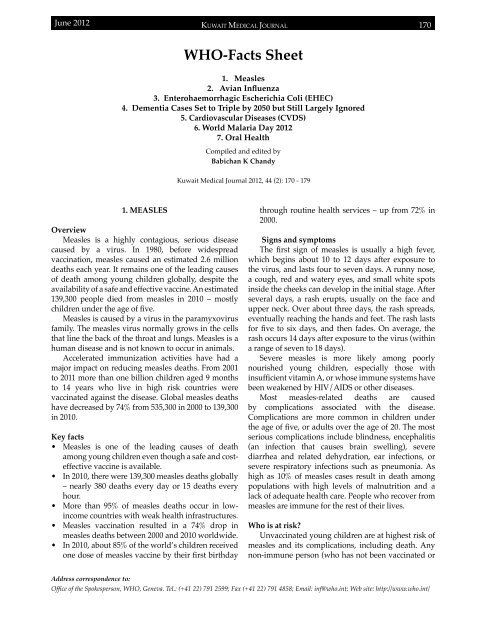Vol 44 # 2 June 2012 - Kma.org.kw
Vol 44 # 2 June 2012 - Kma.org.kw
Vol 44 # 2 June 2012 - Kma.org.kw
You also want an ePaper? Increase the reach of your titles
YUMPU automatically turns print PDFs into web optimized ePapers that Google loves.
<strong>June</strong> <strong>2012</strong><br />
KUWAIT MEDICAL JOURNAL 170<br />
WHO-Facts Sheet<br />
1. Measles<br />
2. Avian Influenza<br />
3. Enterohaemorrhagic Escherichia Coli (EHEC)<br />
4. Dementia Cases Set to Triple by 2050 but Still Largely Ignored<br />
5. Cardiovascular Diseases (CVDS)<br />
6. World Malaria Day <strong>2012</strong><br />
7. Oral Health<br />
Compiled and edited by<br />
Babichan K Chandy<br />
Kuwait Medical Journal <strong>2012</strong>, <strong>44</strong> (2): 170 - 179<br />
1. MEASLES<br />
Overview<br />
Measles is a highly contagious, serious disease<br />
caused by a virus. In 1980, before widespread<br />
vaccination, measles caused an estimated 2.6 million<br />
deaths each year. It remains one of the leading causes<br />
of death among young children globally, despite the<br />
availability of a safe and effective vaccine. An estimated<br />
139,300 people died from measles in 2010 – mostly<br />
children under the age of five.<br />
Measles is caused by a virus in the paramyxovirus<br />
family. The measles virus normally grows in the cells<br />
that line the back of the throat and lungs. Measles is a<br />
human disease and is not known to occur in animals.<br />
Accelerated immunization activities have had a<br />
major impact on reducing measles deaths. From 2001<br />
to 2011 more than one billion children aged 9 months<br />
to 14 years who live in high risk countries were<br />
vaccinated against the disease. Global measles deaths<br />
have decreased by 74% from 535,300 in 2000 to 139,300<br />
in 2010.<br />
Key facts<br />
• Measles is one of the leading causes of death<br />
among young children even though a safe and costeffective<br />
vaccine is available.<br />
• In 2010, there were 139,300 measles deaths globally<br />
– nearly 380 deaths every day or 15 deaths every<br />
hour.<br />
• More than 95% of measles deaths occur in lowincome<br />
countries with weak health infrastructures.<br />
• Measles vaccination resulted in a 74% drop in<br />
measles deaths between 2000 and 2010 worldwide.<br />
• In 2010, about 85% of the world’s children received<br />
one dose of measles vaccine by their first birthday<br />
through routine health services – up from 72% in<br />
2000.<br />
Signs and symptoms<br />
The first sign of measles is usually a high fever,<br />
which begins about 10 to 12 days after exposure to<br />
the virus, and lasts four to seven days. A runny nose,<br />
a cough, red and watery eyes, and small white spots<br />
inside the cheeks can develop in the initial stage. After<br />
several days, a rash erupts, usually on the face and<br />
upper neck. Over about three days, the rash spreads,<br />
eventually reaching the hands and feet. The rash lasts<br />
for five to six days, and then fades. On average, the<br />
rash occurs 14 days after exposure to the virus (within<br />
a range of seven to 18 days).<br />
Severe measles is more likely among poorly<br />
nourished young children, especially those with<br />
insufficient vitamin A, or whose immune systems have<br />
been weakened by HIV/AIDS or other diseases.<br />
Most measles-related deaths are caused<br />
by complications associated with the disease.<br />
Complications are more common in children under<br />
the age of five, or adults over the age of 20. The most<br />
serious complications include blindness, encephalitis<br />
(an infection that causes brain swelling), severe<br />
diarrhea and related dehydration, ear infections, or<br />
severe respiratory infections such as pneumonia. As<br />
high as 10% of measles cases result in death among<br />
populations with high levels of malnutrition and a<br />
lack of adequate health care. People who recover from<br />
measles are immune for the rest of their lives.<br />
Who is at risk?<br />
Unvaccinated young children are at highest risk of<br />
measles and its complications, including death. Any<br />
non-immune person (who has not been vaccinated or<br />
Address correspondence to:<br />
Office of the Spokesperson, WHO, Geneva. Tel.: (+41 22) 791 2599; Fax (+41 22) 791 4858; Email: inf@who.int; Web site: http://www.who.int/
















